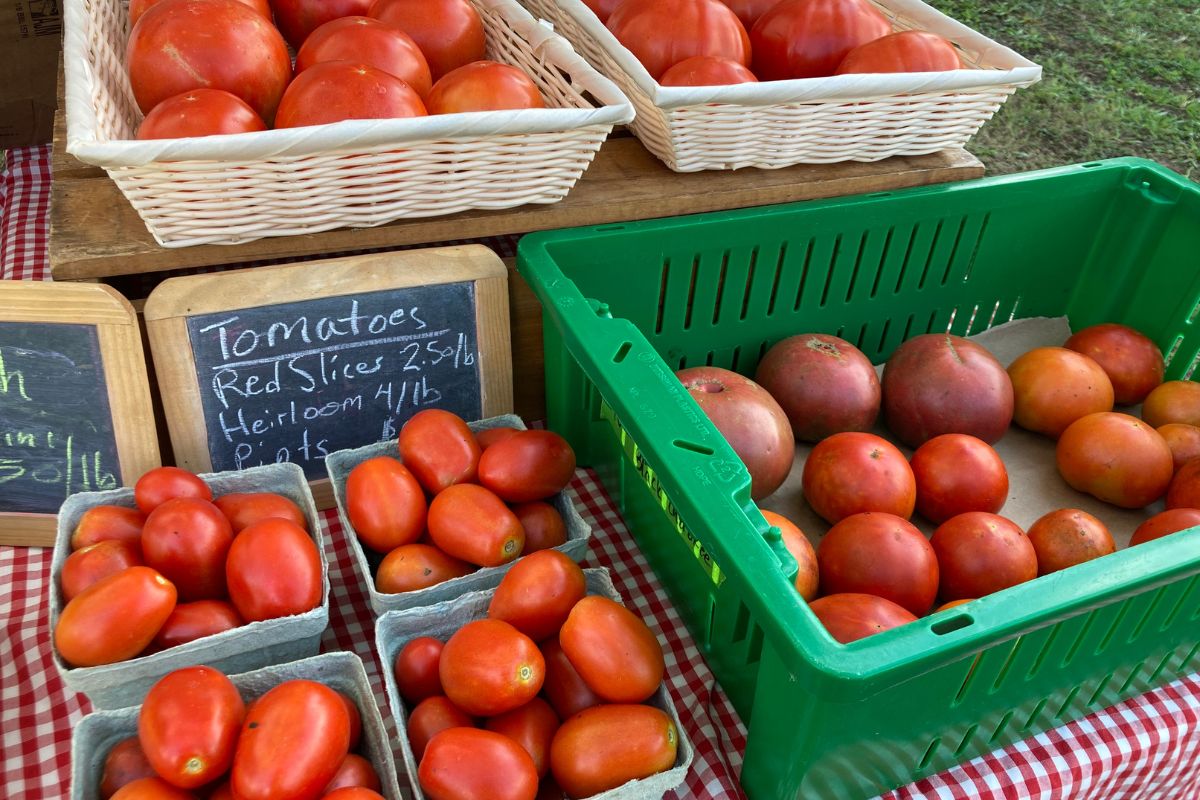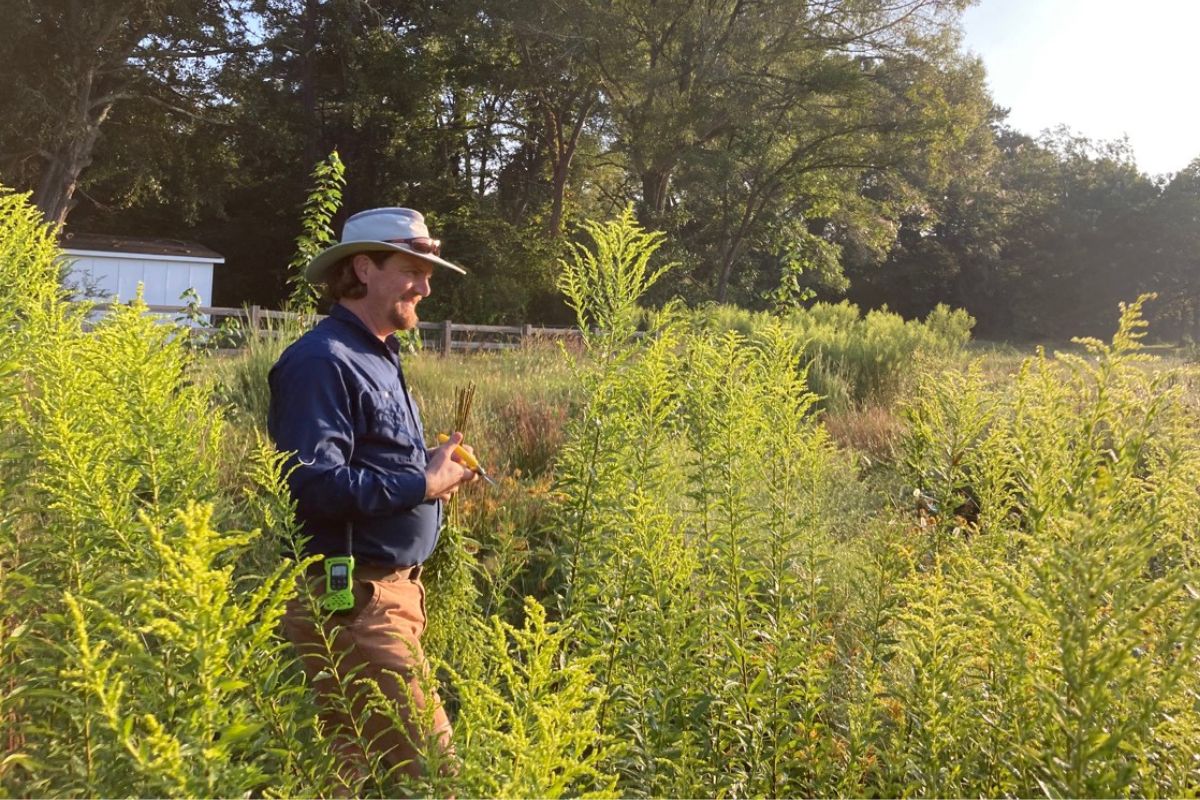At the Oxford College Organic Farm, Daniel Parson’s daily routine changes with the seasons. And no season, he says, brings a stronger wave of optimism than spring. When the light is low at the end of a long day, he’s recently found himself looking out at the rows of broccoli, cabbage and collards that take up about a quarter acre and saying to himself, “That’s beautiful.”
“It’s the joy of watching it unfold and knowing that a new season is upon us,” says Parson, the farm’s lead farmer-educator. “Everyone relates to that coming out of winter, when everything is green and going again.”
Over the last few months, the farm’s staff has been hard at work tilling, planting and harvesting their vernal crops for the annual spring plant sale — a perfect opportunity to get seedlings for your home garden or herbs for your kitchen. The sale is set for Saturday, April 12, on the farm.
The farm’s community-supported agriculture program, through which participants pick up a box of fresh produce every Thursday, begins on April 24.
“I get excited about the spring because people are interested in what we’re doing,” Parson says. “People ask me all the time how to start a garden and tell me what they’ll be planting this year.”
Below, Parson shares six tips on how take advantage — as both gardener and gourmand — of the farm’s many spring offerings.
1. Eat it while it’s fresh.
“Anything you grow in your backyard is going to taste better to you,” Parson says. “Most people think a carrot is a carrot is a carrot. And then they try one of our carrots. They find it has a sweetness, an aroma — it’s just different. Every time someone tries a vegetable like that, it’s exciting to see them light up and say, ‘This doesn’t taste like what I’m used to.’”
Part of the reason the farm’s carrots strike some as fresher than usual is because they are often eaten shortly after being pulled from the ground. They haven’t spent days in transportation or on the shelf. “Most things are going to be at their peak when they’re harvested,” Parson says.
For carrots, that means what we typically buy from the grocery store has already lost its natural, robust flavor.
“The aroma of a carrot is one of the first things to go,” Parson explains, “and its sweetness deteriorates because they’re basically burning sugars while staying alive in storage.”
The other benefit to growing your own produce is that you have a wider variety of options. Much of what is offered at the grocery store, Parson says, is chosen because it grows well at scale, ships easily and will hold up on the shelves. “At home,” he notes, “you can grow things just for flavor.”
2. Start with herbs and potted plants.
Starting a home garden can be daunting. For those who don’t have the space — or just aren’t ready to fully invest the time and care required — Parson recommends starting small with herbs or other vegetables, like certain peppers, that can grow in a pot. Herbs can grow outside or inside — a kitchen windowsill is a popular location — if the spot catches enough sunlight.
“Many of those are perennials,” he says, like thyme, rosemary and mint, “so you can put them in a planter and harvest year after year, season after season.”
He also recommends basil, which is annual. He likes to clip the leaves for pizza. “If I have plenty,” he adds, “I like to make pesto.”
3. Plant in the ground — instead of raised beds.
If you are ready to take the plunge on a full-scale home garden, Parson recommends planting directly into the ground.
“A lot of people want to do raised beds,” he says, “but I always encourage people to think about growing in the ground. To me, it’s more rewarding and easier to amend the soil properly.”
Plants grown in raised beds can drain the soil of its nutrients faster than those grown in the ground, which often have more diverse pathways for soil health, Parson explains.
4. Get your soil tested.
“This is my number one thing,” Parson says. “Take your soil to your local extension office and get their recommendation for amending it.”
He specifically suggests using the University of Georgia Cooperative Extension, which has offices across the state, including one in Newton County, one in DeKalb County and four in Fulton County.
To collect a proper soil sample, the UGA extension program says to pull 10-12 samples from different areas of your potential garden and mix them together in a plastic bin. At the extension office, they will bag a few cups of the mixture for examination. The wait time for results is about two weeks.
After running tests, the extension office will provide a list of nutrients to increase soil health and fertility for your future garden. To incorporate those recommendations, Parson says you’ll need to find a friend with a tiller or try the “double digging” method, which takes a little more elbow grease.
Double digging involves removing the topsoil altogether, mixing the organic matter prescribed by the extension office with the subsoil, and then returning the removed soil to the top layer. For a more in-depth description, Parson says to ask questions at the extension office — about double digging or anything else.
“They can help you with those gardening questions that can’t be answered in a soundbite,” he says. “But having the space, with the right sun, getting the right fertility in there and properly prepared for planting, those are the key starter items.”
5. What to grow first? Try Sungold cherry tomatoes.

The Oxford farm's plant sale will offer more than a dozen varieties of tomatoes.
For those new to gardening in the ground, he suggests something easy to manage: “The first thing I would grow is that Sungold cherry tomato. It’s like liquid sunshine.”
“I want a beginner gardener to have success so they come back and do it again,” he says. “If you don’t do well, you won’t get very many, but you’re going to get at least a few Sungold cherry tomatoes.”
He adds they are great to eat right off the vine or to use for salads and tomato sauces.
6. Experienced gardeners should try heirloom tomatoes, native plants.
Those with more experience may want to branch into heirloom and native species, Parson says.
“The Cherokee Purple is my all-time favorite heirloom tomato, followed closely by the Rose de Berne,” he says. He warns that these two varieties are more high-risk, high-reward endeavors.
“If you don’t do well, you’re not going to get anything,” he explains.
Other heirloom tomatoes he recommends include the San Marzano, the Striped German and the Thai Pink.
Heirloom tomatoes are harder to grow, he says, because they are more susceptible to disease, and many are larger in size and take more time to reach full maturity. “These larger tomatoes, you need friends to share with,” he adds.
The Rose de Berne is smaller than some of the other heirloom tomatoes, and Parson notes it is the perfect size to slice for sandwiches.
All of these heirloom tomato varieties will be available at the Oxford spring sale.
He suggests experienced gardeners also consider purchasing native plants at the sale.
“If you grow something like the golden alexander,” he says, “it will attract pollinators and beneficial insects that help with your pest control.”
Daniel Parson’s favorite crops on offer at the plant sale
Tomatoes:
- Cherokee Purple
- Rose de Berne
- San Marzano
- Striped German
- Thai Pink
Other plants:
- Any of the native plants — “Spotted horsemint, if I must choose.”
- Basil
- Picnic peppers
- Ping Tung Long eggplant
- Dark green zucchini

